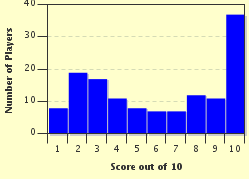Quiz Answer Key and Fun Facts
1. Where was Louis Braille born?
2. What caused Louis Braille's blindness?
3. How was Louis Braille educated?
4. Who provided the inspiration for Louis Braille's invention of a method of reading and writing for the blind?
5. Louis Braille had created the Braille system by age 15. Blind students readily accepted and learned the new code, but their teachers resisted it. Which of the following was NOT a complaint offered by the teachers who opposed the Braille code?
6. Which one of the following instruments did Louis Braille NOT play?
7. Louis Braille also invented raphigraphy. What is it?
8. After his death a small wooden box was found on which was written, "To be burned without opening." Nevertheless, the box was opened. What did it contain?
9. From what did Louis Braille die?
10. Where is Louis Braille buried?
Source: Author
urlybird
This quiz was reviewed by FunTrivia editor
Exit10 before going online.
Any errors found in FunTrivia content are routinely corrected through our feedback system.

